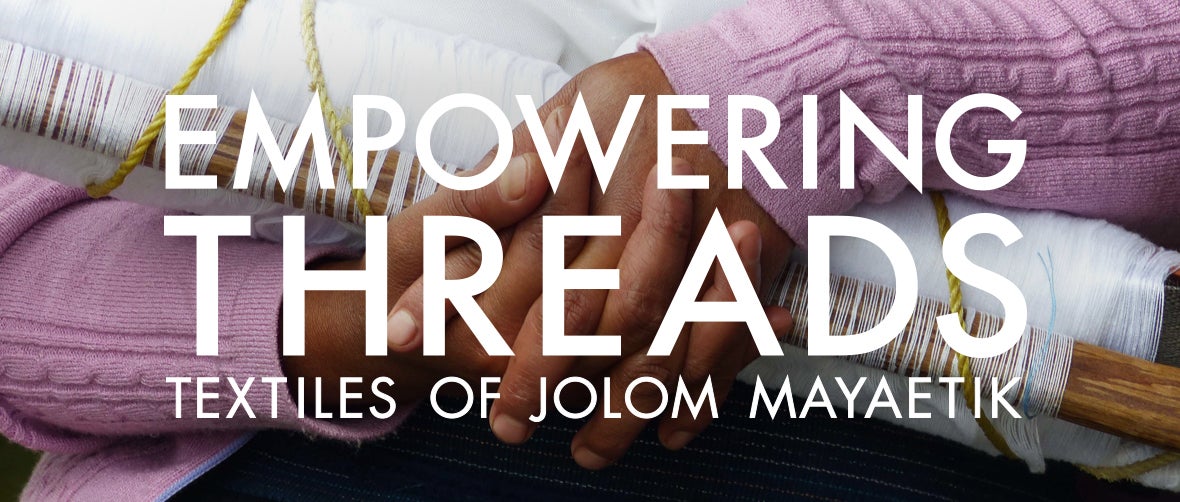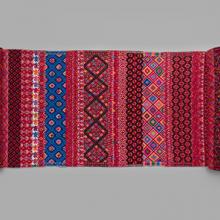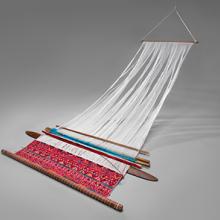Empowering Threads: Textiles of Jolom Mayaetik

International Terminal
Empowering Threads: Textiles of Jolom Mayaetik
A unique and dedicated community of Mayan artisans are weaving brilliantly colored textiles in Los Altos de Chiapas, Mexico. Working on backstrap looms, these weavers are utilizing methods passed down through generations to combine old-world symbolism with new colors and designs. Their most striking textiles are the huipiles woven as ceremonial garments and women’s attire. Huipiles are traditional, loose-fitting women’s blouses, handwoven by panel and sewn together flat. Mayan huipiles vary in style throughout the culturally distinct regions of Chiapas and distinguish the wearer by their locale. Blouses in the blusa Maya style are modern adaptations, with traditional symbols rendered in bright colors never envisioned by their makers’ ancestors.
Many symbols and patterns woven into the textiles of Los Altos adapt designs from ancient Mayan civilizations. The universe design is a diamond-shaped motif that illustrates the edges of the Mayan cosmos by each of its four sides. The sapo, or toad, is a symbol of fertility that springs to life at the start of each rainy season, when singing toads proliferate in cornfields and call for another bountiful harvest. Mayan symbolism may change with each weaver and their interpretation of designs. Meanings of certain older symbols are lost to the ages, with others altered by time and their respective places and cultures. Today, a multitude of contemporary designs are being created by the weavers of Chiapas as personal expressions of their skill and craft.
Traditional Mayan weaving is produced on the backstrap loom, a simple and portable device used for centuries that creates complex work in the hands of a skilled artisan. Textiles may be decorated with intricate brocade, a technique that introduces designs directly into the weaving process using colored thread. In the past, weavers made woven items for themselves, for family members, and to trade. Now they are also produced for sale, and backstrap weaving has become a primary means for indigenous women to earn supplementary income. With recessions, globalization, and privatization of communal farming lands, weaving is increasingly crucial for many families in Chiapas.
The best prices for handwoven textiles are realized through cooperatives. Jolom Mayaetik, which translates to “Women Who Weave” from Mayan Tzotzil, was founded in 1996 and is one of the most progressive weaving cooperatives in Chiapas. The organization promotes sustainable economic development for indigenous women, in a democratic structure run collectively by general assemblies and a popular vote. Unlike more traditional cooperatives in Mexico, the weavers of Jolom Mayaetik are also advancing human rights through educational programs, cultural empowerment, and political mobilization. Committed to improving the lives of indigenous women, members of the Jolom Mayaetik are weaving with a powerful, collective voice. This exhibition features textiles woven by Jolom Mayaetik artisans from the municipalities of San Andrés Larráinzar, Pantelhó, and Oxchuc.
Learn more! Download Empowering Threads: Textiles of Jolom Mayaetik here.
Special thanks to Charlene M. Woodcock, Jolom Mayaetik SCS, and K’inal Antsetik A.C. for making this exhibition possible.
©2017 by the San Francisco Airport Commission. All rights reserved.



![Ceremonial huipil [traditional blouse] c. 2005](https://www.sfomuseum.org/sites/default/files/styles/medium/public/03_empowering_threads_2.jpg?itok=eSb16mRV)
![Blusa Maya [contemporary blouse] 2010](https://www.sfomuseum.org/sites/default/files/styles/medium/public/04_empowering_threads_1.jpg?itok=l2fYg8HF)
![Blusa Maya [contemporary blouse] 2013](https://www.sfomuseum.org/sites/default/files/styles/medium/public/05_empowering_threads_1.jpg?itok=KuvH2OPJ)
![Ceremonial huipil [traditional blouse] c. 2010](https://www.sfomuseum.org/sites/default/files/styles/medium/public/06_empowering_threads_1.jpg?itok=uiktk8AG)
![Tapete [tapestry] 2010](https://www.sfomuseum.org/sites/default/files/styles/medium/public/07_empowering_threads_2.jpg?itok=omiU4Y8j)
![Tapete [tapestry] 2015](https://www.sfomuseum.org/sites/default/files/styles/medium/public/08_empowering_threads_2.jpg?itok=ed2_S7wS)
![Girls’ blusa [blouse] 2008](https://www.sfomuseum.org/sites/default/files/styles/medium/public/09_empowering_threads_2.jpg?itok=tjVvmM9A)
![Blusa [blouse] 2015](https://www.sfomuseum.org/sites/default/files/styles/medium/public/10_empowering_threads_1.jpg?itok=9RnR_lG1)
![Huipil [traditional blouse] c. 2008](https://www.sfomuseum.org/sites/default/files/styles/medium/public/11_empowering_threads_1.jpg?itok=yeu7XaCN)
![Blusa [blouse] 2013](https://www.sfomuseum.org/sites/default/files/styles/medium/public/12_empowering_threads_1.jpg?itok=GPX66Lqr)